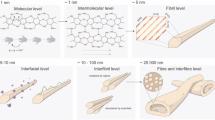Abstract
Mono-functional cellulose propionate segments for use in ter- or star-block polymers have been prepared by the depolymerization (step 1) of cellulose propionate in homogeneous phase using a mixture of HBr and propionic anhydride in methylene chloride solution. The anomeric mixture of glycosyl bromide has subsequently (step 2) been hydrolyzed in aqueous acetone. Functionality was determined by H-NMR spectroscopy of triethyl silane derivatives in combination with gel permeation chromatography. The cellulose ester segments were semi-rigid, highly crystalline materials with melting points between 180° and 250°C. The lowest useful segment size, based on crystallinity and Mark-Houwink-Sakurada exponential factor, appeared to be DP 20, with an optimum around DP 40 to 50.
Similar content being viewed by others
References
Barczai-Martos, M. and Korosy, F. (1950)Nature 165, 369–369.
Camberlin, Y., Pascault, J. P. and Pham, Q.-T. (1979)Makromol. Chem. 180, 397–409.
Ceresa, R. J. (1961)Polymer 2, 213–219.
Fages, G. and Pham, Q.-T. (1979)Makromol. Chem. 180, 2435–2445.
Feger, C. and Cantow, H.-J. (1980)Polymer Bulletin 3, 407–413.
Haney, M. A. (1985a)J. Appl. Polym. Sci. 30, 3023–3036.
Haney, M. A. (1985b)J. Appl. Polym. Sci. 30, 3037–3049.
Kim, S., Stannett, V. T. and Gilbert, R. D. (1973)J. Polym. Sci., Polym. Lett. Ed. 11, 731–735.
Mezger, T. and Cantow, H.-J. (1983)Die Angewandte Makromoleculare Chemie 116, 17–23.
Mezger, T. and Cantow, H.-J. (1984)Polymer Photochemistry 5, 49–53.
Pohjola, L. and Eklund, V. (1977)Paperija Puu 3, 117–120.
Pohjola, L., Harva, O. and Karvinen, J. (1974)Finn. Chem. Lett. 6, 221–224.
Siochi, E. J., Ward, T. C., Haney, M. A. and Mahn, B. (1990)Macromolecules 23, 1420–1429.
Steinmann, H. W. (1970)Polym. Prep. Am. Chem. Soc. Div. Polym. Chem. 11, 285–290.
Author information
Authors and Affiliations
Additional information
Part I has been published in theJ. Appl. Polym. Sci.,49, 1671 (1993).
Rights and permissions
About this article
Cite this article
De Oliveira, W., Classer, W.G. Novel cellulose derivatives. II. synthesis and characteristics of mono-functional cellulose propionate segments. Cellulose 1, 77–86 (1994). https://doi.org/10.1007/BF00818800
Issue Date:
DOI: https://doi.org/10.1007/BF00818800




